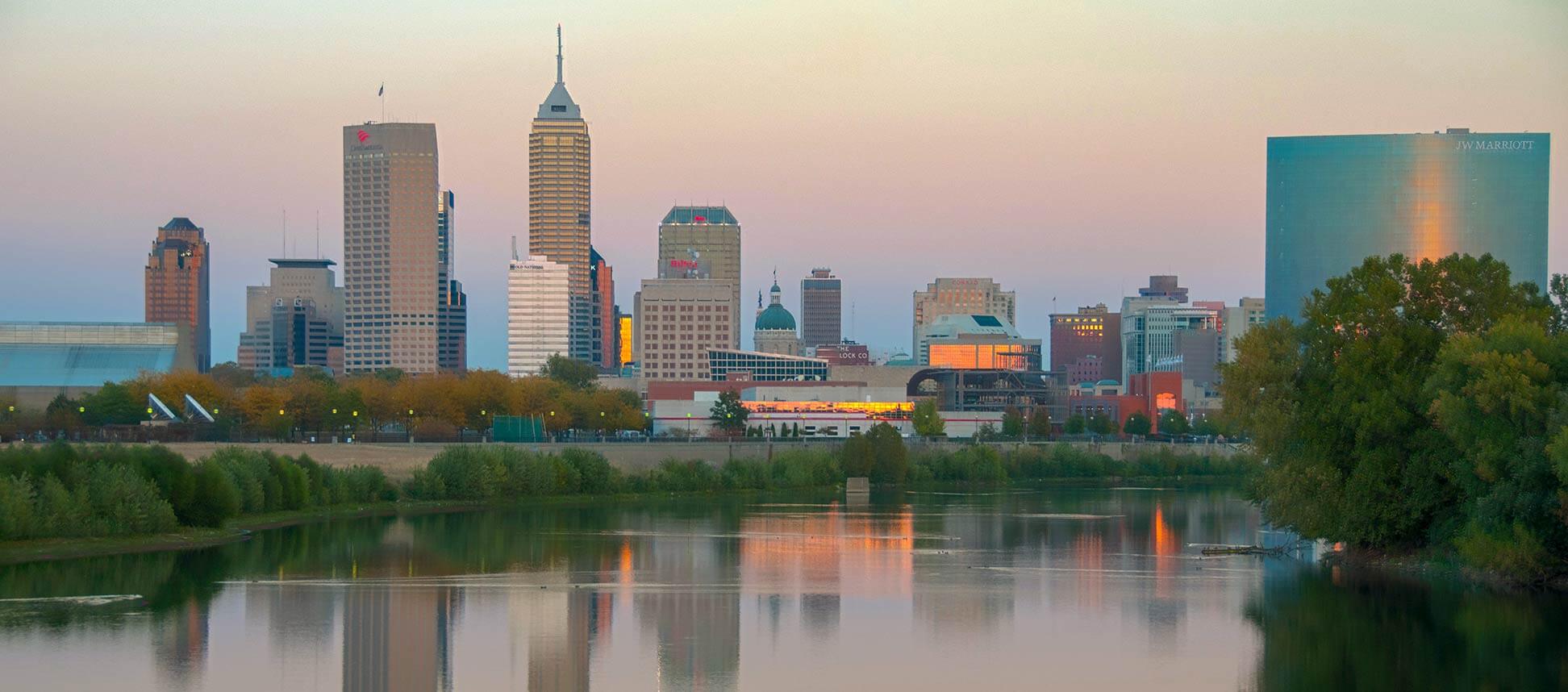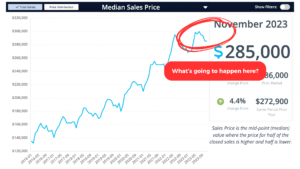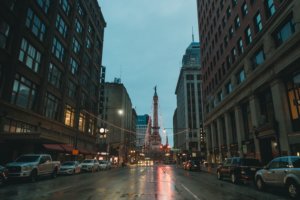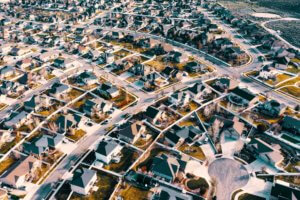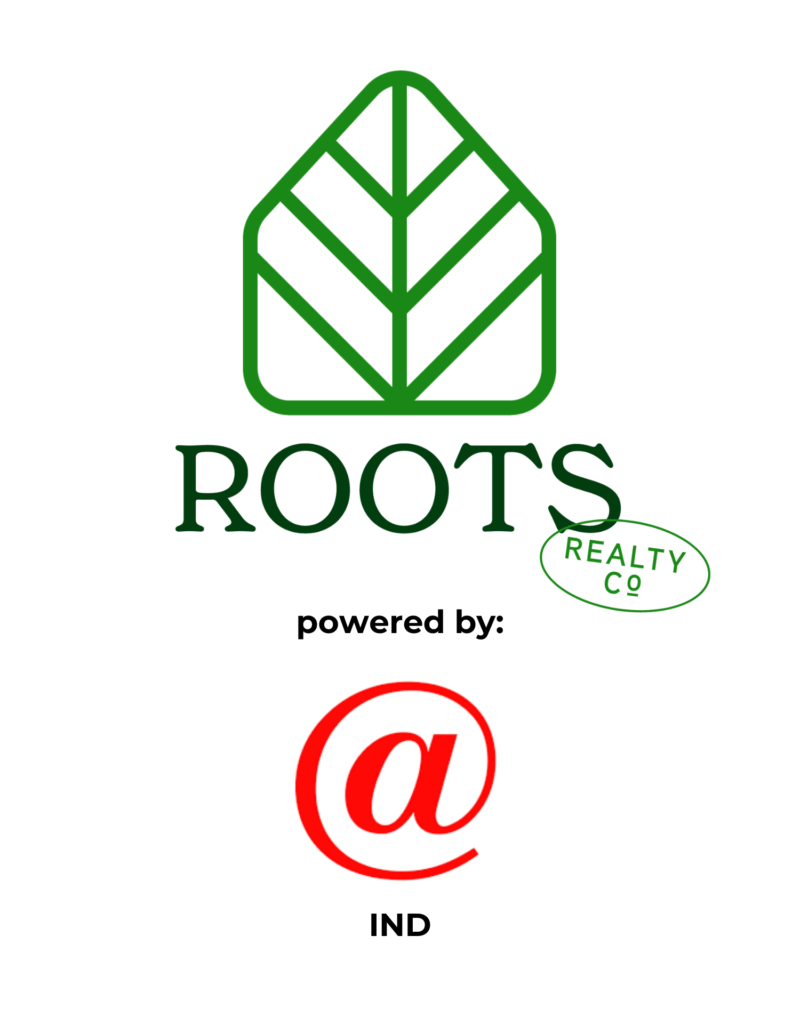Where has the city of Indianapolis been, and where is it going?
I grew up in Avon, Indiana. An Indianapolis suburb planted upon a single stretch of commercial highway on US 36. It’s nothing to nothing to write home about, as it just might be the most inside-the-box suburb you’ve ever seen… Vinyl boxes everywhere, chain restaurants abounding, stoplight after stoplight, no real city center & little-to-no walkability…
My parents, as many others in the 80’s had, left the city of Indianapolis. They bought a nice, modest home in a quiet subdivision of Avon. Really, we enjoyed a quiet peaceful childhood with great friends & families all around us. I loved Avon as a kid. As I grew older I became more and more curious what was happening inside that neighboring looming city, Indianapolis. What was going on there? How could I have lived so close to this major urban city, and yet known so little of its history & where it was going? I decided to find out…
In 2018, at the age of 23, I bought a small bungalow in Irvington, Indianapolis. Irvington is a historic, eccentric neighborhood amidst the rough-and-tumble of Indy’s notorious east-side. I was working downtown as a teacher in a charter school at the time, that is, until I stepped into the wide-open world of Indianapolis real estate…
In the summer of 2021 I sat down with Rex Fisher for our first of many one-on-one chats. I would soon meet with Rex, kindly, for many months and years for coffee. Rex can be likened to an Indianapolis prophet. I use these words because it is with what can only be described as faith that he leads people in real estate & investing towards a greater future for Indianapolis, IN.
In that summer meeting in 2021, he told me, “Tyler, Indianapolis has had more investment in the mile square in the last 5 years than the past 25 years combined, and this is just the beginning.”
This little fact nugget opened my eyes just a bit — What’s going on? What is happening in my slumbering hometown of Indianapolis, IN right now?
I have now learned, Indianapolis, like most mid-major cities, went through a major “white flight” situation in the 70’s & 80’s with the arrival of the Interstates and viable schooling options in the ‘burbs. Now, Indianapolis is 2nd only to Minneapolis, MN with the most individuals leaving work to arrive at home outside the city limits after working in the city limits. During the 90’s and 2000’s, this situation left the city in a brutal situation. Population growth stagnated, and many wealthy families left for the burbs. Tax dollars declined sharply. The schools began to suffer. More families left. Infrastructure was not kept up. Homes & certain neighborhoods became decrepit.

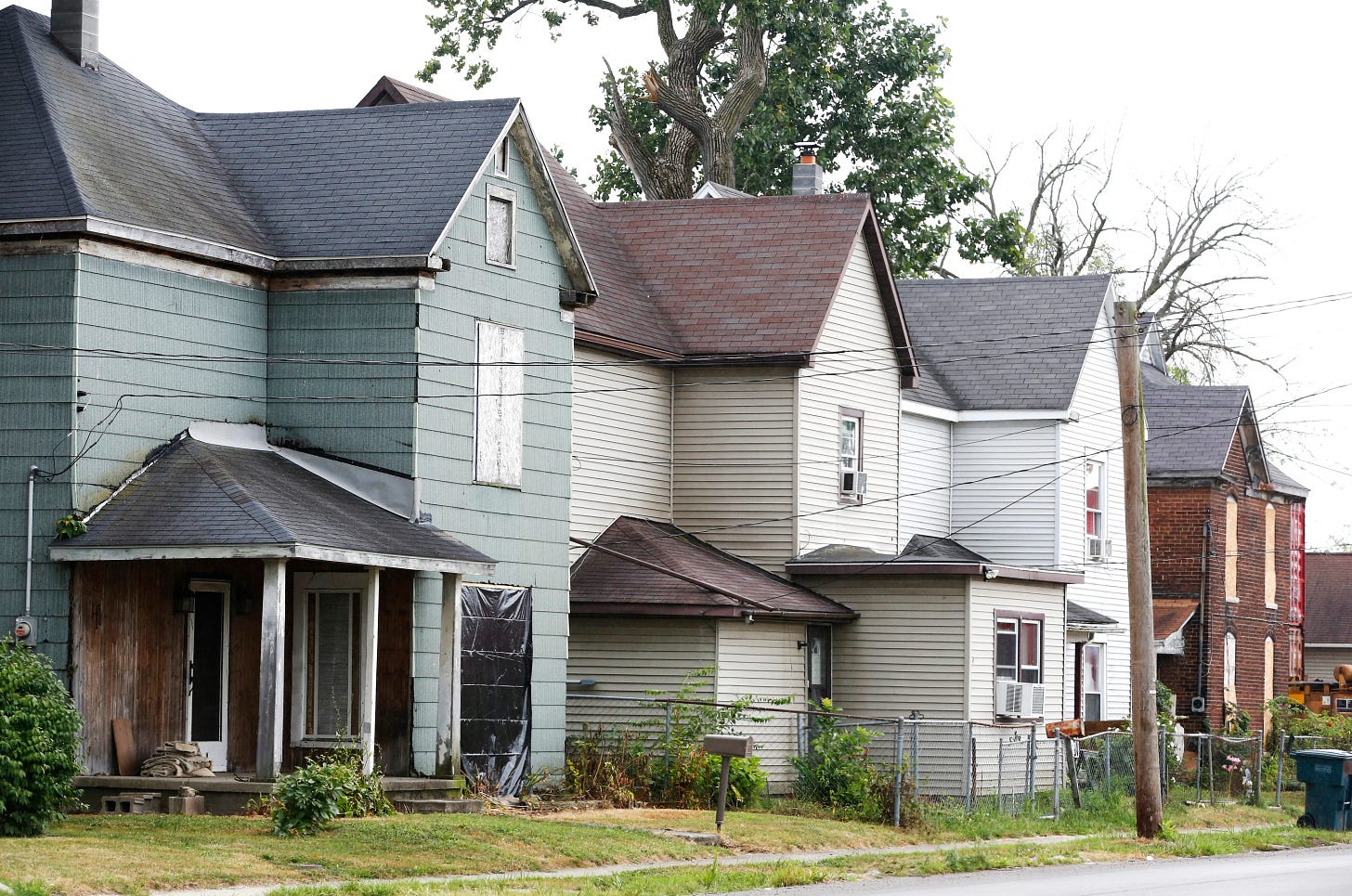
So, what changed?
The city sensed its inevitable decline and made some key political moves, that are just now paying off in big ways:
1970 — Unigov passed — Indianapolis annexed virtually all of Marion County and it’s population nearly doubled.
1972 — Indiana Convention Center opens — Now, one of the largest & busiest convention centers in the nation.
1984 — Baltimore Colts relocated to Indianapolis, first major sports team to be located downtown Indy
1996 — Victory Field opens, hosting Indianapolis Indians minor league baseball
1999 — Gainbridge Fieldhouse is completed, hosts Pacers & Fever teams
early 2000’s — Indianapolis solidifies itself as amateur sports capital of the world, regular host of NCAA championships, Indy 500, Brickyard 400
2008 — Lucas Oil opens, one of the most eminent football stadiums at the time, hosts Superbowl XLVI
2019 — Indianapolis rapid-transit redline opens, first of many lines to open
To now:
IUPUI dissolving in 2024, creating Indiana University & Purdue University Downtown Indianapolis
Indy Eleven soccer park & complex to be completed by 2025
In 2022 Elanco World Headquarters broke ground for new $300M facility in Downtown Indianapolis
Trendy, Mass Ave “Bottleworks District” completes Phase 1 of 3 in 2020
Largest medical development in the U.S. opening in 2025 on the near Northside of Indianapolis with the IU Health buildout
Oh, and a lot more:
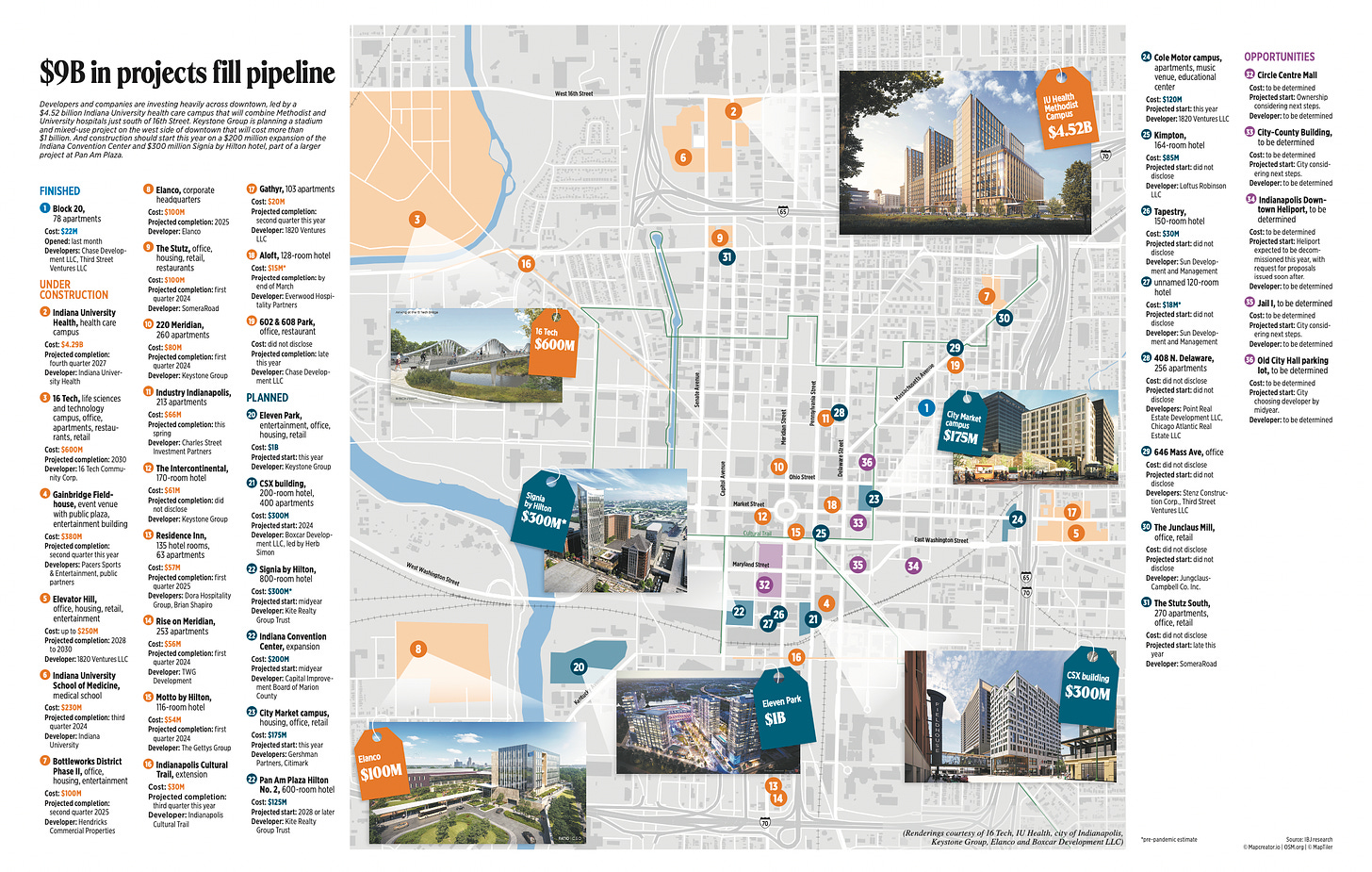
The inevitable result of this development & political movement has been:
Stellar jobs growth & low unemployment (3%), at the time of this writing about 1% lower than the national average. Source
Consistent population growth. From 2010 to 2020 the city grew by 25% in population, exceeding national average. Ample transplantation of people from surrounding areas of Indiana & places like Chicago. Source
Real estate investment. Currently just Downtown Indianapolis has $9B in the pipeline for developments, which ranks Indianapolis as one of the most rapidly developing cities in the nation.
And why would someone want to invest in Naptown U.S.A. a.k.a. Indianapolis, IN?
Here’s a peak at what I’m seeing on the ground as an investor-minded real estate agent…
Linear-and-at-times-hyperbolic value growth. The last decade has seen median price soar in Indianapolis from $135,000 in 2016 to $299,900 in 2023. Even before COVID-era price shocks, Indianapolis had a track record of 2-3% year-over-year appreciation and weathering recessions extremely well compared to other cities. Source
Affordability. Indianapolis is ranked as one of the most affordable cities in the nation to own real estate, with a median price of $230,000 (in city limits) as opposed to $431,000 nationwide for a single-family home. Source: ATTOM Data
Cash Flow. Up until 2022, it was much more affordable to own a home than rent a home in Indianapolis. This did change with the arrival of 7-8% interest rates, but cash flow month-to-month will improve drastically if rates drop into the 5-6% range.
Neighborhood Revitalization. In 2008, the highest sold home in Fountain Square district was $196,000. Flash forward to 2023 where a home just sold for $1.1M in FtSq. Source. This is happening in more areas than just Fountain Square, as we are seeing early major revitalization of the same sort in South Broad Ripple, Fall-Creek & Mapleton Fall-Creek, Garfield Park, Near Eastside, and the Near Westside.
At the time of this writing the median sold price in the Near Westside is $139,955. How long do you think that will last hemmed in by Elanco World HQ, Motor Speedway, and IU Health $4.5B developments?
Indianapolis median price
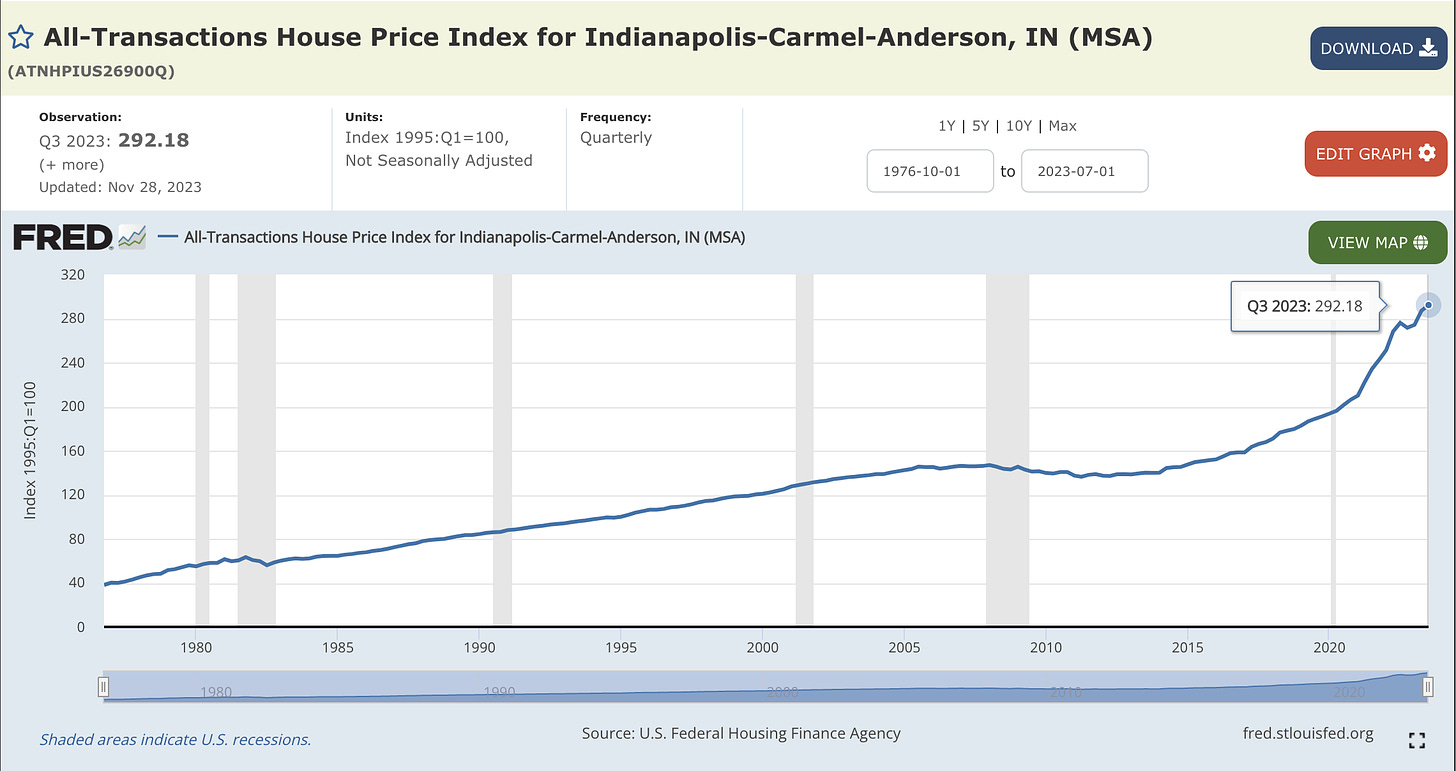
Single family homes selling for mid-$100s in the quickly emerging Near Westside Indy
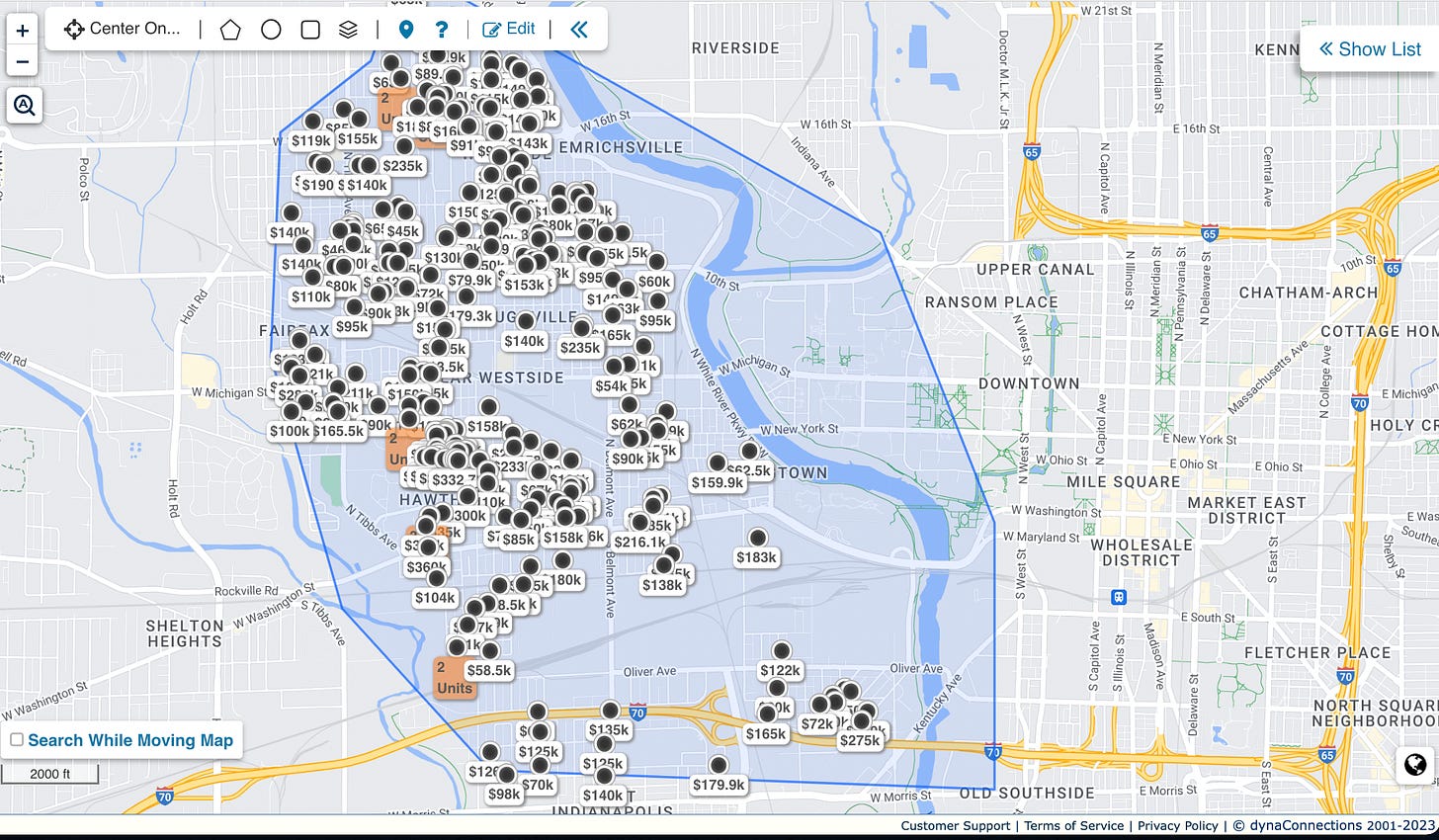
The Conclusion — Where is The Circle City going?
Recently I attended a networking summit discussing the future of the Circle City. The data markers & factors at play blew my mind…
Infrastructure-wise: We have a 20-year Fully Funded Infrastructure plan, Voted top Airport in the nation, A+ National credit rating. Crossroads of America, high density of highways and interstates, Voted best sporting events host cities. Source.
Talent-wise: We currently have #1 Best place for job opportunities in the nation around the corner (Lafyette & West Lafyette), #1 Engineering school (Purdue University), #1 Largest medical school (Indiana University), #2 Ranked city in the nation for jobs, #6 Fastest population growth rate in the U.S. Source.
Industry-wise: We currently have #1 Orthopedics capital of the world, #1 RV Manufacturing capital of the world, #1 Advanced manufacturing jobs, #1 Valued-life sciences company (Elanco), Top-10 Valued company in the world in pharmaceuticals (Eli Lilly), Top 10 producer of agriculture products & natural resources in the nation, and 3 Federal hub designations (Microelectronics, Hydrogen, Biotech). Source.
Technology-wise: We are voted #1 Place to start a tech company, #1 Cell coverage, 2nd Largest physical presence of Salesforce in the world, 2nd Largest FedEx hub in the world, #4 Best city for women in tech, #5 City creating the most tech jobs, Top 8 Rising Tech city, and a $10B Tech company exits in the last decade. Source.
Lifestyle-wise: We currently have Largest Children’s Museum, Voted best place to attend an event, Voted best place to start a business right now, Voted best city for mid-career professionals, a Top 10 cities for Best states for business, and Top 10 best cities for young professionals. Source.
Regulatory-wise: #1 Regulatory environment in the nation, 1 of 14 States with a AAA credit rating, Top 4 States in clean energy capacity, a 3.2% personal income tax rate, 4.9% cooperate tax rate, and a sub 3% unemployment rate. Source.
I know that was a lot of facts & figures but is it not pretty mind-blowing? Here in Indianapolis… In that same event, the speaker drew a comparison between Indianapolis and another major U.S. city. And that was Austin, Texas, due to our tech-friendly atmosphere, logistics & accessibility advantages (Crossroads of America), and low-regulatory environment. I can’t say for certain whether Indianapolis is the next Austin, TX but it sure is exciting to have comparisons drawn from individuals that know what they’re talking about! The full presentation is here.
Where I see Indy going — I see Indianapolis remaining a strong, robust mid-major city for quite some time. Unlike many of the declining rust belt cities, Indianapolis is here to stay. Real estate wise, we will continue to be a major draw for out-of-state capital. For those living inside Indy, the “overton window” of affordability is closing in, pretty quickly. I think we will continue to see Indy get significantly less affordable as the build up continues. It’s an exciting time to be living in Indy. More will come flocking to Indy seeking a safe, affordable place to raise their family, a wide jobs market to build a career, and eventually we may see Indy emerge as a top entrepreneurship hub in the nation. Some may say we are already there. For me, Indianapolis will always be the Hoosier City. A place as welcoming and wide-open as it seems, it’s built into the “Hoosier” way of living.
For those that want to learn more about the developments in Indianapolis and the major revitalizing neighborhoods, use this interactive Google Map I put together.
For those that want access to my Indy Investor Map, with a description of the best and worst locations to invest, how to run the numbers on an investment property, and more — go here:
I also have a newsletter discussing where the real estate market is going in Indy, the best strategies that can work now, and exclusive off / on-market deals.
Access my Indy Investor email newsletter.
I happened to wake up one day and find myself in a thriving, major U.S. city. I’m grateful for this reality and excited to help build the future of Indianapolis.
Thank you for reading.
Subscribe to my Substack. I use it as my journal, where I discuss matters related personal habits, investing in real estate, and spiritual lessons I’m learning.

